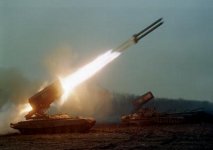




The TOS-1-4 system, which first gained widespread notice in combat in Chechnya, fires a 220mm "flame rocket" which is probably a fuel-air explosive. This type of munition releases a large cloud of flammable gas and cause massive explosions that can clear out bunkers and other fortifications. The TOS-1-4 [expansion unknown] was first displayed publicly at the third international Omsk '99 exhibition of ground and air equipment in June 1999. Held on the grounds of the Polyot aerospace amalgamation, demonstration exercises and firing tests were held at the Svetly township test site. Possibly a prototype, the chassis is based on the T-72 tank. Systems of this type in the West are typically employed for mine-clearing operations, and it is possible that this system was pressed into service in Chechnya for this purpose, as well as to employ the fuel-air explosive area denial munition against Chechen fighters in urban areas.
During the 1994-95 war in Chechnya the Russians were surprised by the sophistication of the Chechen use of booby-traps and mines. Chechens mined and booby-trapped everything, showing excellent insight into the actions and reactions of the average Russian soldier. Mine and booby- trap awareness was hard to maintain among poorly trained Russian troops. In the recent fighting that began in late 1999, the Chechen capital Grozny has been heavily mined by Chechen forces, who are fighting from shelters for grenade-launcher- and machine-gun crews. The Russian military has also charged that Chechen fighters preparing to wage chemical warfare using chlorine, ammonia and sulphuric acid bombs buried in Grozny. The TOS-1-4 system's area denial capability would be useful for both mine-clearing operations, as well as in operations against dug-in troops.In early December 1999 Chechnya accused the Russian military of using an unidentified type of chemical weapon in the assault on Grozny. According to Chechen reports, over 30 people were killed in the attack, which witnesses said produced unusually yellow flames, and more than 200 others suffered various degrees of burns. Although unconfirmed, these reports are suggestive of the incomplete detonation of the fuel aerosol dispersed from a fuel-air explosive. Munitions of this type require precise aerosol dispersal of fuel to ensure proper mixing with atmospheric oxygen, followed by precisely timed firing of a small initiator charge to produce a large explosion. Improper disperal of the fuel aerosol or a mis-timed firing of the initiator could produce a large fireball, but the resulting deflagration would not produce the blast shock wave of the intended explosive detonation. The challenge of reliably producing consistent detonations has limited the application of this type of munition in Western arsenals.
As of 08 December 1999 the United States Department of State acknowledged that they were aware of reports that Russia was using fuel air bombs, but it could not confirm specific reports of their employment. By late December 1999 news agencies were reporting that Russian warplanes had begun dropping powerful aerosol bombs on Chechen bases, sometimes located in caves and deep trenches.
On 28 December 1999 First Deputy Chief of the Russian General staff, Colonel General Valery Manilov, stated that the Russian Federal Forces had not applied what he termed "volume explosion bombs" in the Chechen mountains, although he acknowledged that Russia has such weapons. This denial is noteworthy, in that it does not assert that such weapons have not been used in Grozny, only that they had not been used in other parts of Chechnya. The precise technical scope of this denial is also unclear, in that standard reference sources, such as the Russian Arms Catalog and the ORDATA-II CDROM, do not disclose the fact of the existence of air-delivered fuel-air explosives in the Russian arsenal.
